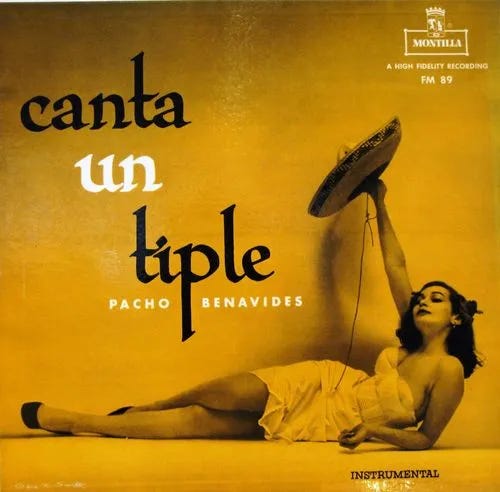EVERY GENRE PROJECT - January 29 - Bambuco
Genre of the Day - Bambuco
Album of the Day - Canta un tiple by Pacho Benavides (1966)
Today, I successfully did the bare minimum that this project requires, which is listening to an album that actually fits the genre I was given! Shouldn’t be hard, but after my failure two days ago, I did certainly fear this happening again. That point of self-deprecation aside, this blogging journey is quite the roller coaster because oftentimes day-to-day I oscillate between albums beloved by music heads, widely known by the general public, with ample content penned on every musical brushstroke, and albums belonging to genres with much smaller regional presences, imbued with just as much beauty but with such a dearth of information about their artists and sounds. It definitely keeps me on my toes: and I imagine it would keep a reader on their toes as well. But therein lies the fun.
Today’s genre is bambuco, which is perhaps the most fun genre name we’ve had yet—something about it just rolls off the tongue and feels so peppy. It’s a string instrument–driven genre with a long tradition hailing from the Andean region of Colombia, up in the high mountains. (Thinking of the Andes makes me sad, for reasons I can’t really elaborate on in the realm of a blog post, but at least this music is mostly happy.) this music is well beloved, with many festivals in the region revolving around its playing, with couples dancing often incorporated as an aspect.
This music draws to mind the fact that so much of music is inherently visual—music is so much more than sound. It is an experience that we associate with our visual surroundings, often not meant to be truly enjoyed on its own, even if that really is the way that counterintuitively seems as if that’s the purest form of consuming music. While listening to this music is beautiful, it exists in tandem with the festivals, the dancing, and the sights of the region which it calls home. It’s a powerful reminder of music as an incorporation of multiple senses—not just hearing.
That being said, the music is still beautiful enough to be appreciated on its own. This album is simple but beautiful—just a single tiple (a twelve-stringed guitar, if you thought six strings wasn’t hard enough). The tiple is such a beautiful sound—there’s a richness to it and a depth to it when strummed, but also a soft, fluty beauty especially on plucked portions that stands it apart from other stringed instruments that I’ve heard. The melodies unfold beautifully, although it’s hard for me to imagine it as a dance genre—it’s not particularly fast-paced, even within what I’m used to for waltz music, and is often plaintive and even mournful. That a single instrument can convey such emotion is a beautiful thing, though, and a reminder of music’s beauty no matter the breadth of instrumentation involved.




